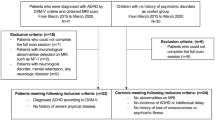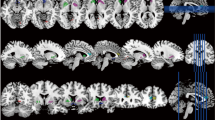Abstract
Attention deficit hyperactivity disorder (ADHD) is a developmental, neurobehavioral syndrome with an onset in childhood. The aim of this study was to investigate the existence of regional perfusion changes in ADHD by means of Tc-99m HMPAO brain SPECT. Thirteen children with a diagnosis of ADHD and 7 healthy, age-matched controls were included in this study. Hypoperfusion was observed on the right temporal cortex in 9, and on the left temporal cortex in 3 children. The distribution of the lesions showed right lateral temporal cortex involvement in 3, right medial temporal cortex in 9 and left medial temporal cortex in 8 children. The distribution of the lesions showed right lateral temporal cortex involvement in 3, right medial temporal cortex in 9 and left medial temporal cortex in 8 children. Asymmetric perfusion was seen on the caudate nucleus in 4, on the thalamus in 3 and on the frontal cortex in 6 children. There was a significant difference between children with ADHD and controls in right medial temporal cortex: cerebellum and righ lateral temporal cortex: cerebellum ratios. Hypoperfusion in the right medial temporal cortex was significantly and inversely correlated with Du Paul teachers’ questionnaire rating scale (r=−0.71, p=0.0006). It has been postulated that difficulty in self regulating response to stimuli in ADHD is mediated by underfunctioning of the orbital frontal cortex and subsequent connection to the limbic system. Decreased temporal cortex perfusion may dysfunction of the limbic system or the orbito-frontal-limbic axis.
Similar content being viewed by others
References
Szatmari P, Offort DR, Boyle MH. Ontario Child Health Study; prevalence of attention deficit disorder with hyperactivity.J Child Psychol Psychiatry 1989; 30: 219–230.
American Psychiatric Association.Diagnostic and Statistical Manual of Mental Disorders. Fourth Edition (DSM IV), Washington DC; American Psychiatric Association, 1994.
Laufer WF, Denhoff E. Hyperkinetic behavior syndrome in children.J Pediatrics 1957; 50: 463–474.
Zametkin AJ, Nordahl TE, Gross M, King AC, Semple WE, et al. Cerebral glucose metabolism in adults with hyperactivity of childhood onset.N Engl J Med 1990; 15: 1361–1366.
Zametkin AJ, Liebenauer LL, Fitzgerald GA, King AC, Minkunas DV, et al. Brain metabolism in teenagers with attention-deficit hyperactivity disorder.Arch Gen Psychiatry 1993; 50: 333–340.
Lou H, Henriksen L, Bruhn P, Borner H, Nielson JB. Striatal dysfunction in attention deficit and hyperkinetic disorder.Arch Neurol 1989; 46: 48–52.
Zametkin AJ, Liotta W. The neurobiology of ateentiondeficit/hyperactivity disorder.J Clin Psychiatry 1998; 59: (Suppl 7): 17–23.
Conners CK. Rating scales in attention-deficit/hyperactivity disorder: use in assessment and treatment monitoring.J Clin Psychiatry 1998; 59 (supply 7): 24–30.
Conners CK. Conners abbreviated symptom questionnaire. North Tonawanda, NY, Multi Health Systems 1994
Du Paul GJ. Parent and teacher rating of ADHD symptoms: Psychometric properties in a community-based sample.J Clin Child Psychol 1991; 20: 245–253.
Wechsler D.WISC-R Manual: Wechsler intelligence scale for children-revised. New York, NY, The Psychological Corp., 1974.
Biederman J, New Corn J, Sprich S. Comorbidity of attention deficit hyperactivity disorder with conduct, depressive, anxiety, and other disorders.Am J Psychiatry 1991; 148: 564–577.
Faraone SV, Biederman J, Chen WS, Milberger S, Warburton R, Tsuang MT. Genetic heterogeneity in attention-deficit hyperactivity disorder (ADHD) gender, psychiatric comorbidity, and maternal ADHD.J Abnorm Psychol 1995; 104: 334–335.
Giedd JN, Castellanos FX, Casey BJ, Kozuch P, King AC, et al. Quantitative morphology of the corpus callosum in attention deficit hyperactivity disorder.Am J Psychiatry 1994; 151: 665–669.
Amen DG, Carmichael BA. High-resolution brain SPECT imaging in ADHD.Ann Clin Psychiatry 1997; 9: 81–86.
Lou HC, Henriksen L, Bruhn P. Focal cerebral dysfunction in developmental learning disabilities.Lancet 1990; 335: 8–11.
Voeller KK. What can neurological models of attention, inattention and arousal tell us about attention deficit, hyperactivity disorder.Clin Neurosci 1991; 3: 209–216.
Casey BJ, Castellanos FX, Giedd JN, Marsh WL, Hamburger SD, et al. Implication of right frontostriatal circuitry in response inhibition and attention deficit/hyperactivity disorder.J Am Acad Adolesc Psychiatry 1997; 36: 374–383.
Barkley RA. Behavioral inhibition, sustained attention and executive functions: constructing a unifying theory of ADHD.Psychol Bull 1997; 121: 65.
The limbic lobes and the neurology of emotion. In:Principles of Neurology, Adams RD, Victor M (ed), New York; McGraw-Hill, Inc., 1989: 409–421.
Alexander GE, DeLong MR, Strick PL. Parallel organization of functionally segregated circuits linking basal ganglia and cortex.Ann Rev Neurosci 1986; 9: 357.
Author information
Authors and Affiliations
Corresponding author
Rights and permissions
About this article
Cite this article
Kaya, G.C., Pekcanlar, A., Bekis, R. et al. Technetium-99m HMPAO brain SPECT in children with attention deficit hyperactivity disorder. Ann Nucl Med 16, 527–531 (2002). https://doi.org/10.1007/BF02988629
Received:
Accepted:
Issue Date:
DOI: https://doi.org/10.1007/BF02988629




